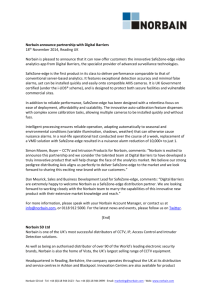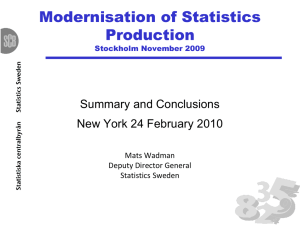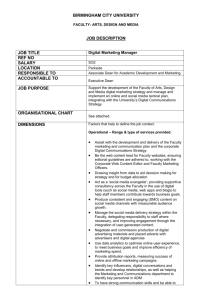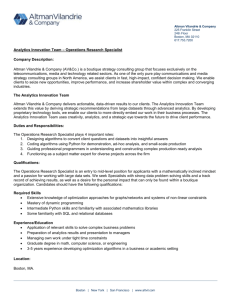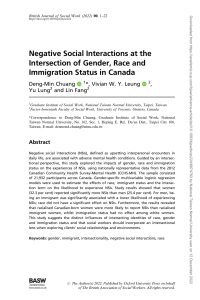Opportunities, Challenges and Risks - Prof. Rob Kitchin
advertisement
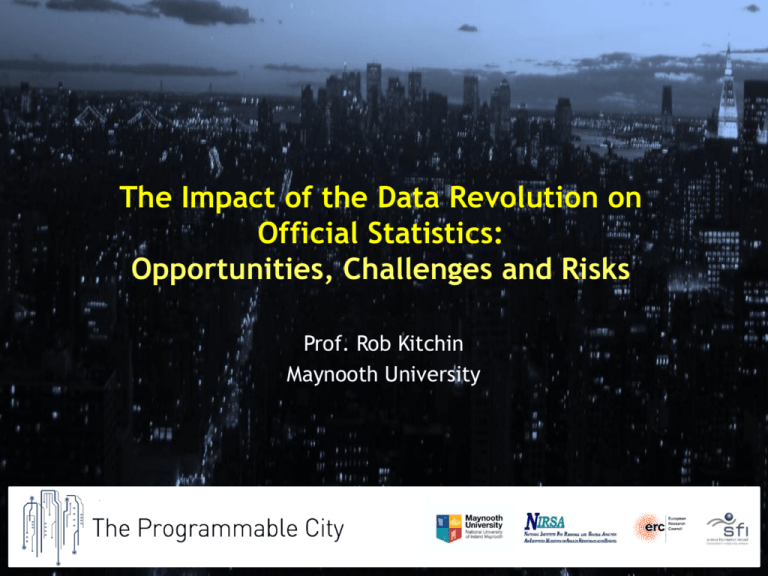
The Impact of the Data Revolution on Official Statistics: Opportunities, Challenges and Risks Prof. Rob Kitchin Maynooth University Background • All-Island Research • • • Observatory (www.airo.ie) Dublin Dashboard (www.dublindashboard.ie) Digital Repository of Ireland (DRI; www.dri.ie) The Programmable City The data revolution • • • • • • • Data infrastructures Open and linked data Big data Data analytics Data markets Data ethics Conceptualisation of data • Create disruptive innovations that offer opportunities, challenges and risks for government, business and academy Data infrastructures • • • • Actively planned, curated and managed Enables storing, scaling, combining, sharing and consuming data across networked archives and repositories NSIs long operated as such trusted data infrastructures Now a need to organise into more coordinated platforms -– National Data Infrastructures, with: • dedicated and integrated hardware and networked technologies; • • interoperable software and middleware services and tools; shared standards, protocols, metadata; shared services, analysis tools & policies Also skilled staffing operating across govt departments/agencies – Irish Government Statistical Service Data within NDIs being federated into larger pan-national infrastructures (Eurostat, ESPON, UN, etc) Open and linked data • • • • • Opening PSI (and other) data for re-use Driven by arguments re. transparency, participation, collaboration, economic development Linking data/metadata using non-propriety formats and URIs and RDF NSIs already very active in this space; other government data providers much further beyond More to be done, especially: • • • • • retro opening and linking of historical records producing APIs & machine-readable formats upgrading extent of openness (licensing re. re-use, reworking, redistribution, reselling) using non-proprietary formats opening data about the organizations themselves Big data Characteristic Small data Big data Volume Limited to large Very large Exhaustivity Samples Entire populations Resolution and indexicality Relationality Coarse & weak to tight & strong Weak to strong Tight & strong Velocity Slow, freeze-framed Fast Variety Limited to wide Wide Flexible and scalable Low to middling High Strong Big data • Diverse range of public and private generation of fine-scale data about citizens and places in real-time: • utilities • transport providers • environmental agencies • mobile phone operators • travel and accommodation • • • • websites social media sites financial institutions and retail chains private surveillance and security firms emergency services Data analytics • Challenge of making sense of big data is coping with its: • abundance and exhaustivity • timeliness and dynamism • messiness and uncertainty • semi-structured or unstructured nature • Solution has been machine learning made possible by • advances in computation Four broad classes of analytics: • • • • data mining and pattern recognition statistical analysis prediction, simulation, and optimization data visualization and visual analytics Big data and official statistics (source ESSC 2014) Data source Mobile communication WWW Sensors Transactions of process generated data Crowdsourcing Data type Mobile phone data Statistical domains Tourism statistics Population statistics Web searches Labour statistics Migration statistics e-commerce websites Price statistics Businesses’ websites Information society statistics Business registers Job advertisements Employment statistics Real-estate websites Price statistics (real estate) Social media Consumer confidence; GDP and beyond; information society statistics Traffic loops Traffic/transport statistics Smart meters Energy statistics Satellite images Land use statistics; agricultural statistics; environment statistics Automatic vessel identification Transport and emissions statistics Flight movements Transport and emissions statistics Supermarket scanner and sales data Price statistics Household consumption statistics Volunteered geographic information Land use (VGI) websites (OpenStreetMap, Wikimapia, Geowiki) Community pictures collections (flickr, Instagram, Panoramio) - Big data and official statistics • Given its scope, timeliness, and resolution big data have captured the interest of: • NSIs • Eurostat, the European Statistical System (ESS) • United Nations Economic Commission for Europe (UNECE) • United Nations Statistical Division (UNSD) • In 2013 EU NSIs signed the Scheveningen • Memorandum to examine the use of big data in official statistics Initial analysis indicates that whilst big data offer a number of opportunities for official statistics, they also offer a series of challenges and risks Big data: opportunities • • • • • • • • • • • • • • Complement, replace, improve, and add to existing datasets/statistics Produce more timely outputs - nowcasting Compensate for survey fatigue of citizens and companies Complement and extend micro-level and small area analysis Improve quality and ground truthing Refine existing statistical composition Easier cross-jurisdictional comparisons Better linking to other datasets New data analytics producing new and better insights Reduced costs Optimization of working practices and efficiency gains in production Redeployment of staff to higher value tasks Greater collaboration with computational social science, data science, and data industries Greater visibility and use of official statistics Big data: challenges • • • • • • • • • • • • Forming strategic alliances with big data producers Gaining access to data, procurement and licensing Gaining access to associated methodology and metadata Establishing provenance and lineage of datasets Legal and regulatory issues, including intellectual property Establishing suitability for purpose Establishing dataset quality with respect to veracity (accuracy, fidelity), uncertainty, error, bias, reliability, and calibration Technological feasibility re. transferring, storing, cleaning, checking, and linking big data Methodological feasibility re. augmenting/producing OSs Experimenting and trialing big data analytics Institutional change management and staff re-skilling Ensuring inter-jurisdictional collaboration and common standards Big data: risks • Mission drift • Data quality and losing control of generation / • • • • • • • sampling / processing Inconsistent access and continuity (breaks in method/time-series) Privacy breaches and data security Damage to reputation and losing public trust Resistance of big data providers and populace Fragmentation of approaches across jurisdictions Resource constraints and cut-backs Privatisation and competition Way forward • • • UNECE Big data sandbox Hosted by Central Statistics office (CSO) and the Irish Centre for High-End Computing (ICHEC) Technical platform to: • • • • • test the feasibility of remote access and processing test whether existing statistical standards / models / methods etc. can be applied to Big Data determine which Big Data software tools are most useful for statistical organisations learn more about the potential uses, advantages and disadvantages of Big Data sets – “learning by doing” build an international collaboration community to share ideas and experiences on the technical aspects of using Big Data Way forward • Need to find common international positions on: • • • • • • conceptual and operational (management, technology, methodology) approach and dealing with risks; other roles NSIs might adopt, such as becoming the arbiters or certifiers of big data quality, or becoming clearing houses for statistics from non-traditional sources resolving issues of access, procurement, licensing, and standards identifying and tackling privacy, ethics, security, legal, and governance issues establishing best practices for change management that will maintain quality standards, continuity and trust resourcing at national and international scales Conclusion • A data revolution is underway • • • • a fundamental shift in data openness and sharing • the scaling into data infrastructures • big data and new data analytics Creating a set of disruptive innovations that are producing opportunities, challenges and risks for NSIs and statistical systems It is important for NSIs to get ahead of the curve with respect to challenges and risks, becoming proactive not reactive and setting the agenda for new data and statistical innovations This requires conceptual, practical, technical and strategic thought and a coordinated approach Conclusion • NSB’s Strategic Priorities for Official Statistics 2015• • • • 2020 sets a framework and roadmap for Ireland Some elements of the Irish Statistical System are already worldclass and at the cutting edge -- CSO, OSI -- in other areas we lag behind The NSB’s Priorities provides a holistic approach for consolidating and extending excellence and aiding the rest of the system to catch up The suggestions re. NDI and IGSS will be especially valuable if implemented Will require reform of data culture, practices, governance and sharing in public sector: which is long overdue Rob.Kitchin@nuim.ie @robkitchin http://www.nuim.ie/progcity @progcity Kitchin, R. (2015) The opportunities, challenges and risks of big data for official statistics. Statistical Journal of the International Association of Official Statistics 31(3): 471-481. Kitchin, R., Lauriault, T. and McArdle, G. (2015) Knowing and governing cities through urban indicators, city benchmarking and real-time dashboards. Regional Studies, Regional Science 2: 1-28 Kitchin, R. and Lauriault, T. (2015) Small data in the era of big data. GeoJournal 80(4): 463475 Kitchin, R. (2014) Big data, new epistemologies and paradigm shifts. Big Data and Society 1 (April-June): 1-12.
